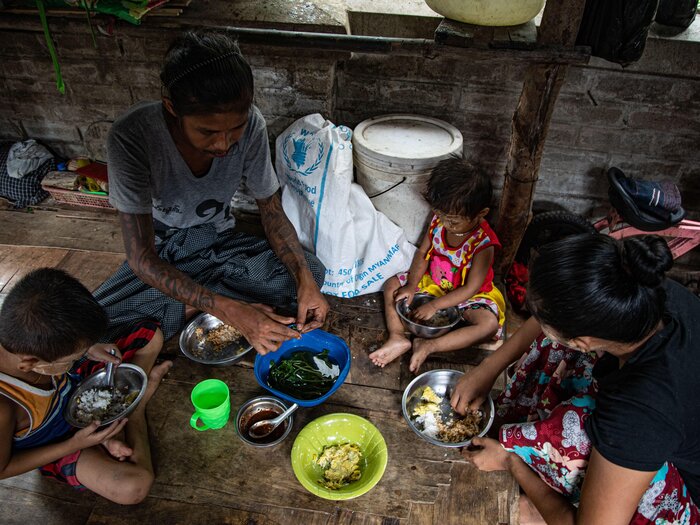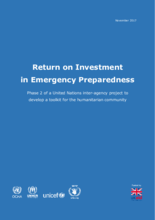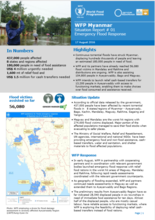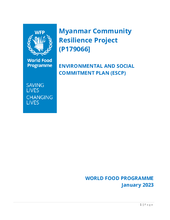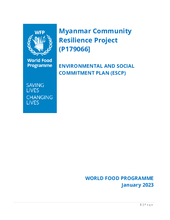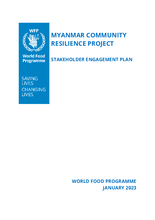Myanmar
- 14.4 million
- people in need of humanitarian assistance
- 13.2 million
- food insecure people
- 54 million
- population
Myanmar faces a complex set of political and socioeconomic challenges. These directly translate into food insecurity, which greatly hampers the country’s ability to end hunger (SDG 2). Myanmar remains one of the least-developed nations in the world: a majority of its people struggle with physical, social and economic access to sufficient, safe and nutritious food. Women, girls, elderly people, persons with disabilities and minorities are particularly affected.
High levels of food insecurity are prevalent in conflict-affected areas within Chin, Kachin, Rakhine and Shan states, Sagaing and Magway regions, as well as Kayah State and other southeastern parts of the country. Food insecurity is also common in many densely populated areas of the Ayeyarwady delta, the central Dry Zone and peri-urban areas of major cities such as Yangon and Mandalay.
Conflict and political crises continue to hinder progress towards ending hunger and malnutrition. Following decades of military rule, the first civilian government was formed in 2016, albeit in a fragile context marred by long-term conflict in several areas of Myanmar. On 1 February 2021, the Tatmadaw (Myanmar’s military) staged a military takeover, ousting the elected civilian government. The political crisis that followed has led to countrywide instability, starting with protests and nationwide general strikes, which resulted in a surge in conflict between various armed groups (including many that formed post-takeover) and the Tatmadaw. At the same time, massive disruptions or slowdowns have been noted in a number of sectors that include banking, healthcare, education and transportation.
In early 2022, almost 900,000 people are displaced across Myanmar, of whom more than 521,000 have been displaced since the military takeover. Meanwhile, more than 1 million Rohingya refugees from Myanmar remain in Bangladesh, most of whom fled violence in Rakhine between October 2016 and August 2017.
What the World Food Programme is doing in Myanmar
-
Crisis response
-
WFP provides unconditional food and cash assistance to people affected by conflict, inter-communal violence and climate-related disasters, and who have limited or no livelihood options. WFP currently assists over 360,000 internally displaced and conflict-affected people in Kachin, Shan, Chin and Rakhine states, who live in prolonged displacement. Where needed, the monthly basic food basket is supplemented by fortified blended food to address malnutrition in mothers and children under 5. In response to rising food insecurity among urban populations as a result of the COVID-19 pandemic and political crisis, WFP is scaling up its response, targeting up to 2 million people in Myanmar’s main urban centres.
-
School meals
-
WFP implements a school meals programme targeting over 400,000 pre- and primary school students in more than 4,000 schools during the academic year (June 2021 to February 2022). Children receive midday biscuit snacks or on-site cooked meals with locally procured food. Cooked meals, while mainly funded by WFP, also include ingredients contributed by parents and the community. WFP provides onsite feeding where schools are open, or take-home rations if premises are not open in some areas.
-
Asset creation and livelihoods
-
WFP provides a basic food basket or cash-based assistance, combined with nutrition messaging, to women and men from vulnerable population groups as they participate in the creation and rehabilitation of community infrastructure. These activities are often carried out as an early-recovery measure, to support the rebuilding and restoration of people’s livelihoods after a disaster. WFP promotes equal wages for women and men, through community sensitization.
-
Nutrition
-
To improve nutrition and address stunting in children under 5 years of age, WFP provides children, adolescent girls, and pregnant and nursing women, with specialized nutritious foods or cash assistance, combined with a comprehensive nutrition package. This contributes to meeting their essential nutrient needs and to preventing and treating malnutrition.
-
Food-by-prescription
-
To ensure nutritional recovery and treatment success, WFP provides people living with HIV and on antiretroviral therapy, as well as tuberculosis patients, with a food basket, specialized nutritious foods and counselling support.
-
COVID-19 and common services
-
With the onset of the global COVID-19 pandemic, WFP adjusted its operations to safeguard the people we serve, as well as our staff, by minimizing the risk of transmission. As lead agency for the logistics sector, WFP provides logistics support and coordination to humanitarian partners in Myanmar. Following the cancellation of most commercial flights in 2020, WFP began running a humanitarian air service between Yangon and Kuala Lumpur, as well as Laos. WFP also temporarily provided a domestic humanitarian air service between Yangon and Sittwe between October and December 2020, following a COVID-19 outbreak in Rakhine State. WFP also provides on-demand cash transfer services on behalf of the UN and other partners, to help affected populations meet their essential needs.
Myanmar news releases
Go to pageFind out more about the state of food security in Myanmar
Visit the food security analysis pageOperations in Myanmar
Contacts
Office
United Nations Building No. 20-25 Kyine Tone Street Zawana Theidi Quarter, Oattara Thiri Township Nay Pyi Taw, Myanmar
Nay Pyi Taw
Myanmar (Burma)

